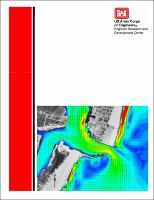Please use this identifier to cite or link to this item:
https://hdl.handle.net/11681/7640| Title: | Two-dimensional depth-averaged circulation model M2D: Version 2.0, report 1, technical documentation and user's guide |
| Authors: | Militello, Adele Reed, Christopher W. Zundel, Alan K. Kraus, Nicholas C. |
| Keywords: | Circulation model Coastal inlets Hydrodynamics M2D model Numerical modeling Surface-Water Modeling System Coastal Inlets Research Program (U.S.) |
| Publisher: | Engineer Research and Development Center (U.S.) |
| Series/Report no.: | Technical report (Engineer Research and Development Center (U.S.)) ; no.ERDC/CHL TR-04-2 |
| Abstract: | The two-dimensional (2-D) circulation model M2D, developed under the Coastal Inlets Research Program conducted at the U.S. Army Engineer Research and Development Center, Coastal and Hydraulics Laboratory, has been designed for local applications, primarily at inlets, the nearshore, and bays. M2D is computationally efficient, easy to set up, and has features required for many coastal engineering applications including robust flooding and drying, wind-speed dependent (time-varying) wind-drag coefficient, variably- spaced bottom-friction coefficient, time- and space-varying wave-stress forcing, efficient grid storage in memory, two hot-start options, and the convenience, through control statements, of independently turning on or off the advective terms and mixing terms. If wave information is available, such as through coupling with the STeady state spectral WAVE model STWAVE, M2D will calculate wave friction and wave mixing. M2D can be coupled to regional circulation models through boundary conditions providing flexibility for large-scale applications and connectivity between models. A graphical interface for M2D has been implemented within the Surface-Water Modeling System (SMS) Versions 8.1 and higher. Features of the M2D interface are grid development, control file specification, model runs, post-processing of results, and visualization. M2D can be driven by larger-domain circulation models, such as ADCIRC, through boundary specification capabilities contained within the SMS. The Steering Module in SMS provides an automated means of coupling of M2D with STWAVE, which is convenient for projects that require wave-stress forcing for M2D as well as wave friction and mixing owing to breaking waves. The Steering Module allows the user to choose from seven possible coupling combinations, providing flexibility in conducting simulations of wave-driven currents and wave-current interaction. |
| Description: | Technical Report |
| Gov't Doc #: | ERDC/CHL TR-04-2 |
| Rights: | Approved for public release; distribution is unlimited |
| URI: | http://hdl.handle.net/11681/7640 |
| Appears in Collections: | Technical Report Technical Report |
Files in This Item:
| File | Description | Size | Format | |
|---|---|---|---|---|
| CHL-TR-04-2.pdf | ERDC/CHL TR-04-2 | 1.86 MB | Adobe PDF |  View/Open |